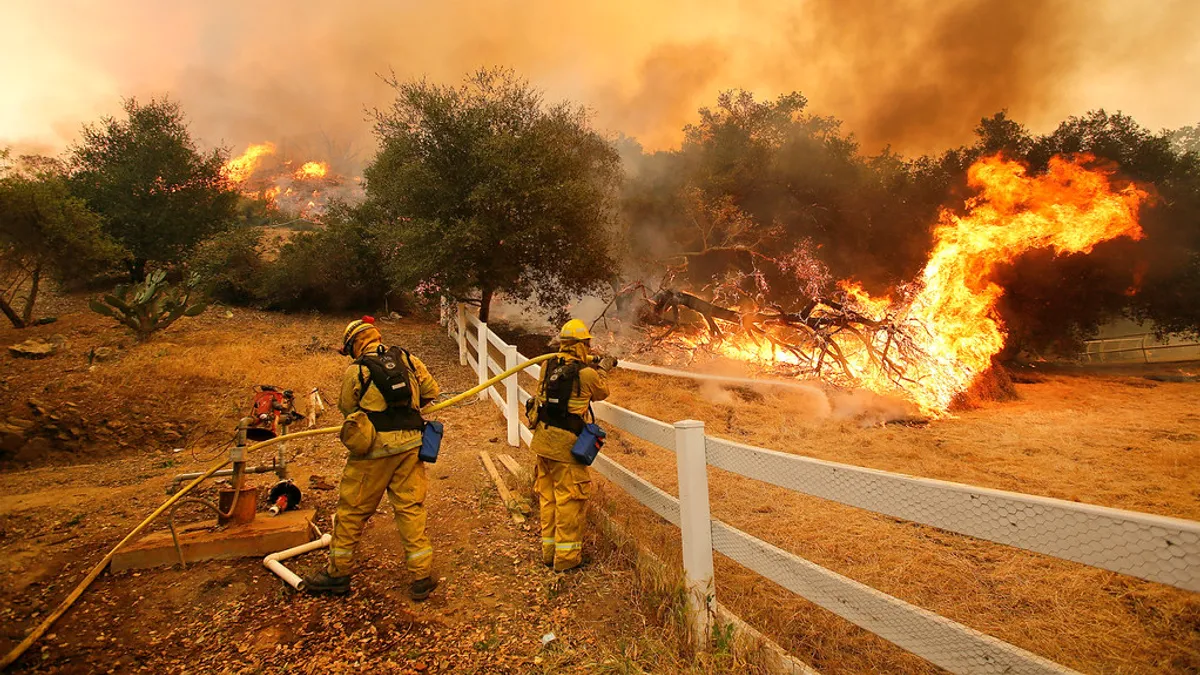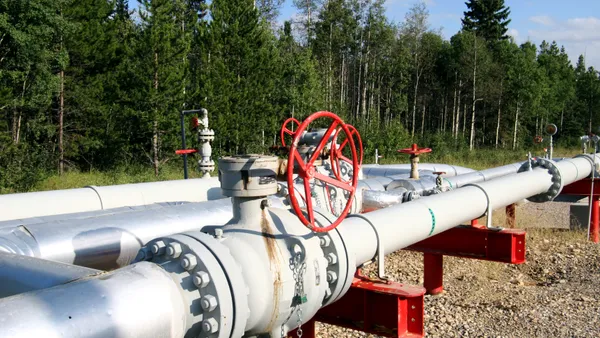Dive Brief:
-
Analysts at S&P Global Ratings have lowered the outlook for California's investor-owned utilities to "negative" from "stable" due to unprecedented wildfire activity during the 2020 fire season, the agency announced Wednesday.
-
The lack of adequate rainfall, dry environment and other factors increase "the likelihood that a California investor-owned electric utility could potentially be the cause of a catastrophic wildfire," according to S&P. And the "deteriorating conditions" could also impact how utilities manage regulatory risk.
- The announcement is another indication that California's severe wildfire conditions have negative implications for utilities, shareholders and customers as well, Steven Weissman, a lecturer at the University of California, Berkeley's Goldman School of Public Policy, said. "Utilities and customers are likely over the course of time to face higher costs, because we have not done an adequate job of managing our wildlands," Weissman added.
Dive Insight:
There were roughly 25 major wildfires burning in California as of Wednesday, according to the state's Department of Forestry and Fire Protection, bringing the collective number of acres burned in 2020 to 3.3 million.
"None of them has been ignited by utility equipment as far as anybody can tell, but it's still having a financial impact on utilities," Weissman said, adding, "what's happening now is that the utilities have to conduct their businesses within the existing environment, and the existing environment includes a very dramatic likelihood that there will be more fires — and it'll be very severe."
In research updates issued Wednesday, S&P revised the outlook for San Diego Gas & Electric (SDG&E), Pacific Gas & Electric (PG&E) and parent company PG&E Corporation, and Southern California Edison (SCE) and parent company Edison International to negative.
In 2019, California decision-makers set up a $21 billion wildfire insurance fund — seeded by utility shareholders and ratepayers — to address the financial implications of the wildfires. But while that fund reduces utilities' credit risk exposure to a certain extent, it doesn't automatically replenish, according to the analysts.
"The evidence of wildfire acceleration in just the beginning of this wildfire season could, in our view, increase the probability of a California investor-owned electric utility causing a catastrophic wildfire, depleting the wildfire fund sooner than expected," S&P said.
California could very easily wind up repeating the cycle of 2017 and 2018, which led to billions of dollars in wildfire liabilities, Weissman said. And if it were to exhaust the wildfire fund, it would be very difficult to replenish, since that would require raising rates for ratepayers or getting contributions from utility shareholders.
One cause for concern for utilities is the pace of the fires, according to S&P. During the 2019 wildfire season, less than 260,000 acres burned in the state during the entire wildfire season, destroying less than 750 structures and causing three fatalities. This year — despite it being early stages of the state's wildfire season — fires have burned more than 3 million acres, damaged more than 5,300 structures and caused more than 20 fatalities, according to S&P.
"We believe the acceleration of adverse wildfire conditions is partially affected by the 2020 below-average rainfall, which we believe could potentially signal a longer and more devastating wildfire season," analysts said, contributing to "a very difficult regulatory and political environment."
The fires come against the backdrop of broader challenges to California's electric landscape, including rolling blackouts initiated in August as a result of high temperatures and energy demand. S&P expects that utilities will have to deploy more public safety power shut-offs — which are specifically used during times of wildfire risk — as well. And if outages and shut-offs become more common, "frustrated customers and politicians could negatively affect California's investor-owned electric utilities ability to consistently manage regulatory risk."
PG&E spokesperson James Noonan said in an emailed statement that the utility is working to further reduce the threat of wildfire through its community wildfire safety program, and that the creation of the state's wildfire fund was an important measure to mitigate the impacts of wildfires and bring financial stability to energy providers.
"We are committed to continuing to work together with first responders and other stakeholders for the duration of the historic 2020 fire season and in the years ahead," Noonan added.
"S&P’s revised global ratings outlook on SDG&E is directly related to wildfire risk the entire west coast is experiencing, and not a reflection of SDG&E’s strong and stable financial performance and history of effective wildfire mitigation and prevention programs," SDG&E said in an emailed statement.
Edison International declined to comment.















